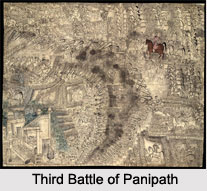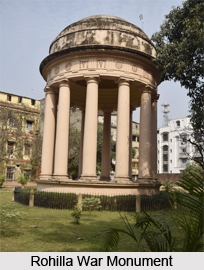 Modern History of Bareilly defines the chapters from the First Rohilla War of 1773-1774, the insurgence of Rohillas, and the end of Maratha and Awadhi conflict. With the rise of British Government in India, the railways were established. But the end of rule of British East India Company came with the First Revolution for Indian Independence that was upraised in 1857.
Modern History of Bareilly defines the chapters from the First Rohilla War of 1773-1774, the insurgence of Rohillas, and the end of Maratha and Awadhi conflict. With the rise of British Government in India, the railways were established. But the end of rule of British East India Company came with the First Revolution for Indian Independence that was upraised in 1857.
The First Rohilla War and Rohilkhand
The First Rohilla War was a corrective campaign by Shuja-ud-Daula, Nawab of Awadh, against the Rohillas, Afghan highlanders settled in Rohilkhand, northern India. The Rohillas came from Afghanistan under the rule of Aurangazeb to give the extra pressure to Rajputs. The Nawab was supported by troops of the British East India Company, in a successful campaign brought about by the Rohillas reneging on a debt to the Nawab. The combined forces of Shuja-ud Daulah, the Nawab of Awadh and the forces of British East India Company led by Colonel Champion defeated Hafiz Rahmat Ali Khan in 1774. Hafiz Rahmat Khan Barech was killed in the ensuing battle at Miranpur Katra in 1774. His death finally closed the chapter of Rohilla rule from Bareilly. Rohilkhand fell to Awadh, was plundered and occupied. The majority of the Rohillas left. They fled across the Ganga River in numbers, to start a guerilla war; or emigrated. A Rohilla state under British protection was set up in Rampur. The Rohillas, after fifty years` precarious independence, were subjugated in 1774 by the confederacy of British troops with the Nawab of Oudh`s army, which formed so serious a charge against Warren Hastings. There was a second Rohilla War, in 1794. Rohilkhand was handed over to the Nawab of Awadh. From 1774 to 1800, the province was ruled by the Nawabs of Awadh. Faiz-ullah, the son of Ali Muhammad who escaped to the north-west and became the leader of Rohillas. After many negotiations he affected a treaty with Shuja-ud-daula in 1774, by which he accepted Nine Parganas worth 1.5 million a year, giving up all the remainder of Rohilkhand to the Wazir of Rampur State. Saadat Ali was appointed governor of Bareilly under the Oudh government.
Bareilly under British Rule
 By 1801, the subsidies due under the various treaties for support of a British force had fallen into hopeless arrears. In order to defray the debt, Nawab Saadat Ali Khan surrendered Rohilkhand to the British East India Company by the treaty of 10th November 1801. After the Rohilla War, the change of the power structure did little to soothe the troubled strife torn area; rather the change had the effect to aggravate a precarious state of affairs. There was a general spirit of discontent throughout the district. In 1812, an inordinate enhancement in the revenue demand and then in 1814 the imposition of a new house tax caused a lot of resentment against the British. Mr. Henry Wellesley, brother of the Governor General, was appointed president of the Board of Commissioners sitting in Bareilly. In 1805, Amir Khan, made an inroad into Rohilkhand, but was driven off. Disturbance occurred in 1816, in 1837 and in 1842 but the peace of the district was not seriously endangered until the Mutiny of 1857.
By 1801, the subsidies due under the various treaties for support of a British force had fallen into hopeless arrears. In order to defray the debt, Nawab Saadat Ali Khan surrendered Rohilkhand to the British East India Company by the treaty of 10th November 1801. After the Rohilla War, the change of the power structure did little to soothe the troubled strife torn area; rather the change had the effect to aggravate a precarious state of affairs. There was a general spirit of discontent throughout the district. In 1812, an inordinate enhancement in the revenue demand and then in 1814 the imposition of a new house tax caused a lot of resentment against the British. Mr. Henry Wellesley, brother of the Governor General, was appointed president of the Board of Commissioners sitting in Bareilly. In 1805, Amir Khan, made an inroad into Rohilkhand, but was driven off. Disturbance occurred in 1816, in 1837 and in 1842 but the peace of the district was not seriously endangered until the Mutiny of 1857.
Annexation of Rohilkhand
Rohilkhand was annexed by British in 1801. Rohilkhand was divided into two districts, Bareilly and a comparatively new city of Moradabad. Shahjahanpur district was formed in 1813-14; Budaun in 1824; the south of Nainital district was taken away in 1858 and sixty-four villages were given, as a reward for loyalty, to the Nawab of Rampur. Pilibhit was made a separate district in 1879.
Bareilly- The Seat of Indian National Congress
Indian National Congress came into prominence in Bareilly during the Khilafat Movement when Mahatma Gandhi visited this town twice and many Hindus and Muslims were arrested. In response to the call given by Mahatma Gandhi, the Civil Disobedience Movement in the district was launched on Jan 26, 1930. In 1936, a conference of the Congress was held in Bareilly under the presidency of Acharya Narendra Deo. It was addressed by Jawaharlal Nehru, M.N. Roy, Purushottam Das Tandon and Rafi Ahmad Kidwai. In 1942 when the Quit India Movement was launched, many processions and meetings were organised and nearly 200 persons were arrested. More prominent among them were Damodar Swaroop Seth, Brijmohan Lal Shastri, P.C. Azad, Rammurti, Naurang Lal, Chiranjivi Lal, Udho Narain D.D. Vaidya and Darbari Lal Sharma. In the Bareilly Central Jail at that time were confined such prominent leaders as Jawaharlal Nehru, Rafi Ahmad Kidwai, Mahavir Tyagi, Manzar Ali Sokhata and Maulana Hifazul Rahman.



















